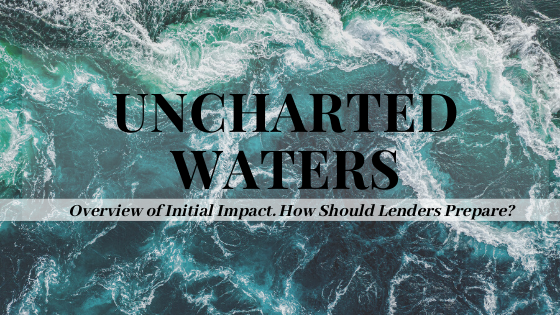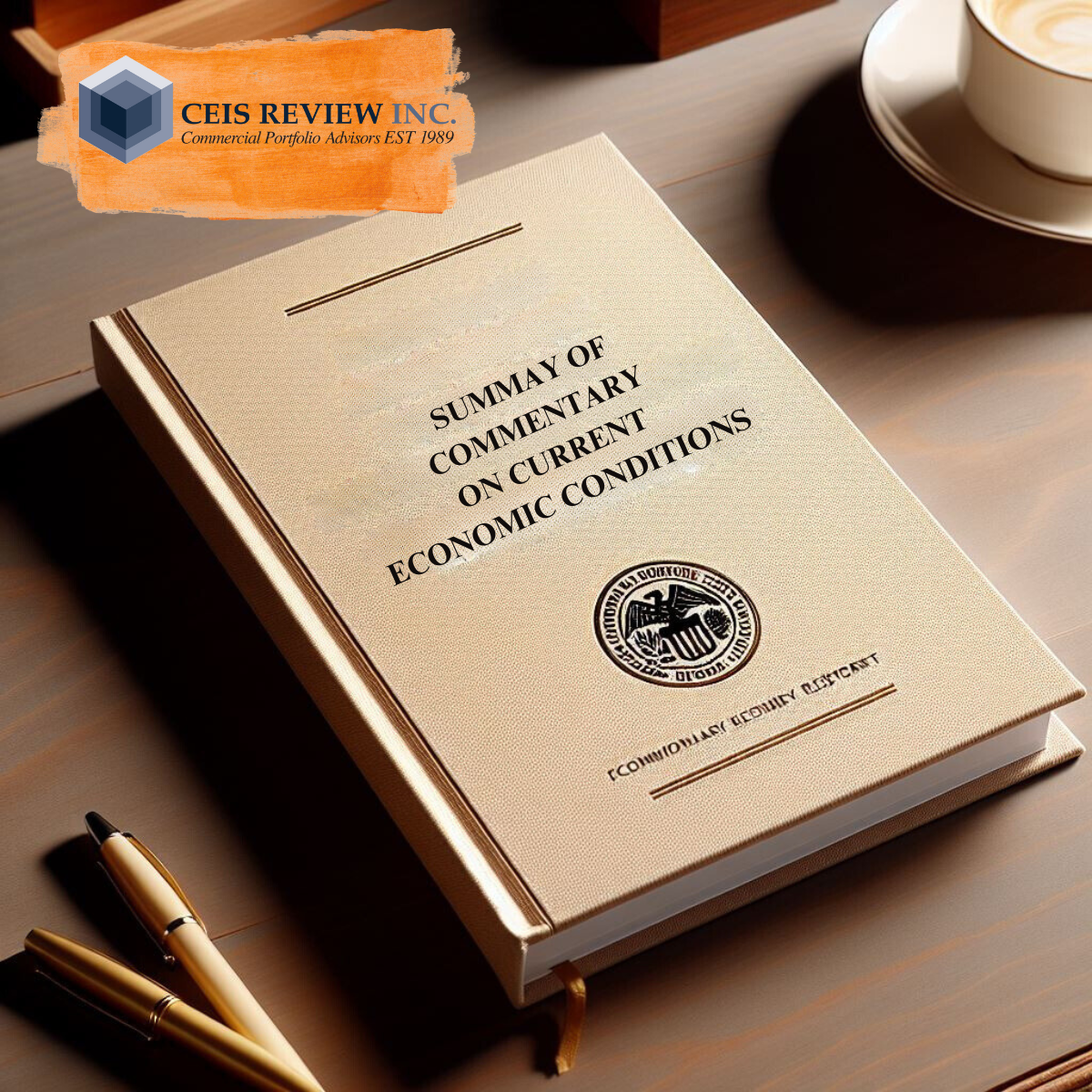Overview of Initial Impact. How Should Lenders Prepare?
Over the last few weeks, I’ve been researching the potential financial impact of the COVID-19 Pandemic and reflecting on the economic aftermath relative to previous crises. Although there are some commonalities in all crises (i.e. volatility, disruption), I believe that COVID-19 is profoundly different. The harsh reality is, with a few exceptions, the global economy to been put on pause. Despite the best efforts of governments, the cessation of economic activity will translate into signification production and job losses and consequently a sharp economic contraction, and for lenders, ultimately loan defaults.
Below I share some high-level summary insights and reflection on how credit professionals within US lending institutions can prepare to defend their portfolios against the forthcoming carnage from the COVID-19 Pandemic. Note that while the below analysis and discussion focuses primarily on the US market, it can also be applied internationally as the COVID-19 Pandemic is a global phenomenon.
Currently lenders are focused on business continuity planning, and at the top of that list is contingency funding and capital preservation. However, unlike previous crisis (i.e. 2008/2009 credit crisis) it is not an endogenous issue with financial institution but rather an exogenous shock to lenders customer base, which will ultimately result in impaired credit portfolios. Concurrently, lenders, are granting new credit, most significantly under government sanctioned programs (e.g. SBA/PPP), which will result in additional portfolio monitoring responsibilities.
Lenders are currently confronted with the daunting tasking of assessing current loan portfolios and providing assessments of probabilities of default over the next few cycles. The onset of the Q2 earnings season indicates that money center banks have already begun to take large provisions. For reference JPM Chase and Wells Fargo have already taken a $6.8 bn and $3.0 bn provisions for Q2 respectively, mainly linked to consumer lending activities. It is likely that increased provisions will follow once the assessment of commercial portfolios are complete and the destructive impact on client business is clearer. Further compounding the dilemma is the prolonged “borrower friendly” era of the past 9 years, characterized by low interest rates and looser structurers. In fact, according to the Federal Reserve Bank of St. Louis, from Mar 2011 to Mar 2020, the US experienced commercial and industrial loan growth of approximately $1.38 trillion, or 114% credit growth.
MACRO ANALYSIS
During the global credit crisis, the US government stimulus measures were designed to bolster the banking system and unfreeze credit markets. While current stimulus measures are intended to grant borrowers liquidity lifelines and maintain employment. The immediate negative impact is significant and we can anticipate downward revisions the longer the economy is stalled. JPM Chase economists forecast an annual economic (GDP) contraction of 20% to 40% with Q2 unemployment increasing from 10% to 20%. A macroeconomic forecast can be utilized as an initial baseline that can be adjusted based on factors such as:
- Industry/sector risk impact (see below) and
- Borrower specific financial strength/credit quality and
- Facility structure factors such as collateral/security, loan covenants and short-term maturity debt profile.
SECTOR ANALYSIS
While from a macro perspective, there is nearly ubiquitous negative impact, lenders can make further adjustments to particularly hard-hit sectors. Below follows a summary of negatively affected sectors1 including but not limited to:
Travel Industry
The industry has been battered and in the most detailed analysis of this article. Boeing was already under pressure due to safety issues with the 737 max model and now the outlook is made more dire with cancelled orders. The lack of demand due to significant reduction in travel applies to other aircraft manufacturers and the respective supply chain. Similarly results of bleak for airline companies, cruise ships, resorts and all that support the industry. Some harrowing albeit noteworthy figures to consider2:]
- Port Authority of NY/NJ cite passenger throughput is down 95% in NYC metropolitan airports for week of April 6, compared to 2019.
- Worldwide airline capacity down 73% with North America down 72%.
- Only 6 out of a 242 delivered ‘jumbo’ Airbus 380 are still flying.
- In the largest 25 US markets hotel occupancy was down 68.5%.
- On the bright side the US Government has approved a $2.9 billion relief package.
Leisure and Entertainment
Lenders who have exposure to professional sports franchises, theme parks, museums and event planning venues (i.e. weddings) and cinema companies will be exposed to lost revenues and consequently insufficient operating cash flow needed to service debt. An example from Hollywood, provides prospective. In February 1,091 movies were short while in March there were 0. On the flip side, the “house arrest” phenomenon has been a boon for all kinds of media as socially distancing consumers increase consumption.
Public Sector/Governments
Federal, local and state governments have been forced to increase funds and hence are experiencing massive budget deficits as a consequence of increased emergency spending (stimulus programs, unemployment insurance and pandemic assistance, etc.) combined with a sharp decline in tax revenues. Further hard hit, cash strapped states may have challenges finding continue support from the US Congress, with Senator McConnell open to idea of letting states file for bankruptcy. The Federal Government although highly leveraged with debt to GDP currently at 80% compared to 35% prior to the global financial, crisis, is still within a good position due to global demand for save haven assets. On a global scale central banks have pledged massive global funding support as evidenced by the World Bank pledging $8 trillion in support, primarily directed towards lower income countries. Eventually these debts will come due and lenders exposed to the public sector may need to revise risk ratings on direct and contingent municipal, state and even sovereign exposures.
Real Estate and Construction
Mortgage forbearance and delayed rent will turn into loan modifications and defaults. The longer the shutdown the deeper the mountain of delayed debt service. Most of the initial issues will relate to properties are challenged to operate remotely (i.e. restaurants and bars, retailers, gyms, hair and nail salons, day care and non-essential medical offices (e.g. dentists). However, depending on the duration of shelter in place orders, corporate offices (many of which have remote capabilities) may seek to restructure leases as the paradigm shift to remote work with many commercial leases cancelled or downsized (e.g. international bank Standard Chartered has indicated that remote work may become permanent for many staff). According to CBRE, US office vacancy rates jumped 20 bps in Q1; the largest increase since 2010. Importantly this figure indicates the trend but not the magnitude of the impact on vacancy. Q2 data will be more telling yet based on the indicators, lenders can begin to asset impact of real estate exposures and revaluation of collateral (i.e. new appraisals).
Many construction projects will be delayed or perhaps even cancelled. Lender should expect cost overruns and project delays and look to structural enhancements such as pre-funded interest reserves and personal guarantees.
Food Supply
There have been reported incidents of contagion at food processing plants (Smithfield, Tyson, etc.) resulting in temporary plant closures, which has contributed to a supply chain disruption. Further, there are also demand shocks, such as school and restaurant closures, which have resulted in discarded supply of perishable goods (i.e. milk, fruit). On the other hand, stay at home orders have increased purchases at supermarkets. Lenders should respective borrower position within the food supply chain and impact on plant closures on operating productivity and where applicable (i.e. asset back loans) the valuation of collateral.
Global Supply Chain
On a broader context, lenders should consider its borrower’s place within its respective global supply chains and the relative impact on operating performance. The China/US trade war was a precursor to the impact of supply chain disruption and reformation. Now in the wake of COVID-19 there is a perceived global movement for companies to diversify supply chains and lessen reliance on Chinese manufacturing. Lenders should examine borrower’s supply chains, exposure to China, logistics disruption and impact on working capital efficiency ratios.
Energy
With prices at historical lows (i.e. recent occurrence of previously unconceivable negative WTI futures), inefficient producers and those without vertically integrated operations are in serious jeopardy and pose increased default risk. In fact, there has already been an initial wave of bankruptcy filings and expectation is for there to be many more. A lot of energy loan facilities have collateral in the form of production or reserves. As value of pledged collateral becomes sufficiently impaired, borrowers will need to “top up” collateral levels to remain in compliance. Those without sufficient unencumbered production will pushed into technical default.
Retail
The “Amazon impact” had already caused significant market share losses for retailers. Pouring gasoline on the fire, the Pandemic has forced retailers to close stores, and these closures can well become permanent. Affected retailer with adequate liquidity and capability to generate revenues through e-commerce may be able to weather the storm. After years of struggles, JC Penny has finally acquiesced to bankruptcy. COVID-19 was the final nail in its coffin. However, an encouraging sign is that below investment grade retailer, GAP recently tapped the capital markets for a $2.25 billion issuance.
PORTFOLIO MANAGEMENT TIPS
Based on macro and industry baseline adjustments, lenders can proactively update individual borrower and facility grades and make necessary provisions for the forecasted impact on individual borrower’s credit quality. Some recommended guidelines include:
- Engage with front line business development staff to expediently receive updated financial statements and projections.
- Stress test financial statements, in particular cash flow generation to arrive at revised debt service capacity.
- Appraise and revalue collateral (real estate, borrowing bases, etc.)
- Test financial covenants and then evaluate borrower’s capability to comply. For borrowers (there will be many) who are under pressure, in particular those in impacted sectors, it might be advisable to immediately begin restructuring discussions.
Currently it’s a challenge to find optimism but here’s a possible silver lining… Unlike the global financial crisis, lenders generally have sufficient capital to handle the initial impact of the Pandemic. The next challenge will be in assessing and monitoring the aftermath of COVID-19. Furthermore, unlike the global financial crisis, the downturn may not be as protracted and the severity of the decline may be countered by a sharp rally, a so called “V” based recovery.
Those lenders that carefully prepare may well weather this storm and actually benefit in the long term with improved borrower relationships and standing with regulators.
Mr. John Weinshank Executive Consultant CEIS Review Inc.







